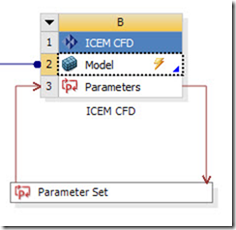FLEXnet Licensing is a member of the FLEXnet Publisher family of products. It is the most popular licensing system used in the software industry.
ANSYS, Inc. Licensing Guide
This guide applies to all products licensed with the ANSYS License Manager.
Chapter 5: Troubleshooting
Documentation for ANSYS ICEM CFD 14.5
Elements of the ICEM CFD Component
ICEM CFD system header.
Model cell.
Table 1: Updating ICEM CFD Projects
Setting Parameters
Setting Input parameters in Workbench enables you to pass parameters to ICEM CFD and other downstream analysis tools.
Setting Input Parameters
You can set the following input parameters in Workbench:
Global Mesh Size (See Global Mesh Size in the ANSYS ICEM CFD Help Manual).
Shell Meshing (See Shell Meshing Parameters in the ANSYS ICEM CFD Help Manual).
Volume Meshing (See Volume Meshing Parameters in the ANSYS ICEM CFD Help Manual).
Prism Meshing (See Prism Meshing Parameters in the ANSYS ICEM CFD Help Manual).
Surface Mesh Setup (See Surface Mesh Setup in the ANSYS ICEM CFD Help Manual).
Curve Mesh Setup (See Curve Mesh Setup in the ANSYS ICEM CFD Help Manual).
Edge Params (See Edge Params in the ANSYS ICEM CFD Help Manual).
Setting the parameters for a single curve, surface, or edge
Setting the parameters for all existing curves, surfaces, or edges
Setting User-Defined Input Parameters
![]() FLUENT Documentation (too many guides . .
FLUENT Documentation (too many guides . .
The manuals listed below form the FLUENT product documentation set. They include descriptions of the procedures, commands, and theoretical details needed to use FLUENT products.
FLUENT Getting Started Guide contains general information about getting started with using FLUENT and provides details about starting, running, and exiting the program.
FLUENT Migration Manual contains information about transitioning from the previous release of FLUENT, including details about new features, solution changes, and text command list changes.
FLUENT User's Guide contains detailed information about running a simulation using the solution mode of FLUENT, including information about the user interface, reading and writing files, defining boundary conditions, setting up physical models, calculating a solution, and analyzing your results.
ANSYS FLUENT Meshing User Guide contains detailed information about creating 3D meshes using the meshing mode of FLUENT.
FLUENT in Workbench User's Guide contains information about getting started with and using FLUENT within the Workbench environment.
FLUENT Theory Guide contains reference information for how the physical models are implemented in FLUENT.
FLUENT UDF Manual contains information about writing and using user-defined functions (UDFs).
FLUENT Tutorial Guide contains a number of examples of various flow problems with detailed instructions, commentary, and postprocessing of results.
ANSYS FLUENT Meshing Tutorials contains a number of examples of general mesh-generation techniques used in ANSYS FLUENT Meshing.
FLUENT Text Command List contains a brief description of each of the commands in FLUENT’s solution mode text interface.
ANSYS FLUENT Meshing Text Command List contains a brief description of each of the commands in FLUENT’s meshing mode text interface.
FLUENT Adjoint Solver Module Manual contains information about the background and usage of FLUENT's Adjoint Solver Module that allows you to obtain detailed sensitivity data for the performance of a fluid system.
FLUENT Battery Module Manual contains information about the background and usage of FLUENT's Battery Module that allows you to analyze the behavior of electric batteries.
FLUENT Continuous Fiber Module Manual contains information about the background and usage of FLUENT's Continuous Fiber Module that allows you to analyze the behavior of fiber flow, fiber properties, and coupling between fibers and the surrounding fluid due to the strong interaction that exists between the fibers and the surrounding gas.
FLUENT Fuel Cell Modules Manual contains information about the background and the usage of two separate add-on fuel cell models for FLUENT that allow you to model polymer electrolyte membrane fuel cells (PEMFC), solid oxide fuel cells (SOFC), and electrolysis with FLUENT.
FLUENT Magnetohydrodynamics (MHD) Module Manual contains information about the background and usage of FLUENT's Magnetohydrodynamics (MHD) Module that allows you to analyze the behavior of electrically conducting fluid flow under the influence of constant (DC) or oscillating (AC) electromagnetic fields.
FLUENT Population Balance Module Manual contains information about the background and usage of FLUENT's Population Balance Module that allows you to analyze multiphase flows involving size distributions where particle population (as well as momentum, mass, and energy) require a balance equation.
FLUENT as a Server User's Guide contains information about the usage of FLUENT as a Server which allows you to connect to a FLUENT session and issue commands from a remote client application.
Running FLUENT Under LSF contains information about using FLUENT with Platform Computing’s LSF software, a distributed computing resource management tool.
Running FLUENT Under PBS Professional contains information about using FLUENT with Altair PBS Professional, an open workload management tool for local and distributed environments.
Running FLUENT Under SGE contains information about using FLUENT with Sun Grid Engine (SGE) software, a distributed computing resource management tool.
Release 14.5 - © SAS IP, Inc. All rights reserved.
1、mechanical APDL是ANSYS的经典界面,通常所说的ANSYS指的就是这个经典界面,大多数教材介绍ANSYS时也是指这个经典界面。
2、workbench是ANSYS推出的一个CAE软件(比如三维建模软件、流体力学计算软件)整合平台,从字面意思上讲,workbench就是工作台的意思,当特指ANSYS Workbench时指的就是这个软件平台。
3、为什么要推出workbench?因为mechanical APDL与CAE软件的相互交流比较困难,workbench在一定程度上弥补了这样的缺点。
4、在界面布局上相比,mechanical APDL继承的是它的传统风格,与一般的CAE软件(比如AutoCAD、CATIA)不同;workbench的界面则与CAE软件比较像,界面相对更加友好。
5、从功能上来说,两者都能独立的完成有限元分析,但由于软件定位不同,mechanical APDL更像是一个求解器,功能强大;workbench则更注重于不同软件之间的相互沟通,在有限元分析这一块的功能不及前者
The Mechanical APDL Product Launcher
Starting an ANSYS Session from the Start Menu/Launcher
Use the launcher to select product settings, such as the simulation environment, the specific license, and any add-on modules or analysis type you want to run.
i am not clearly yet how it to work for me ?
auxiliary [aux·il·ia·ry || ɔːg'zɪljərɪ]n. 辅助者 adj. 辅助的;
AQWA 的小常识
1. AQWA是一个求解器,用来建模 、加载和求解,但它跟普通的软件不一样,它没有操作界面,只有一个文件读入窗口,而且读入的文件只能是 *.DAT 。因此所有的建模、加载和求解都要以在 *.DAT文件中编辑来完成。AQWA就是一个有入口和出口的封闭的加工厂,我们无法看到它的加工过程,只能在输入后等待输出;我们输入编辑好得到 *.DAT文件,就会有一些文件的输出,输出文件会放置在输入文件所在的文件夹里。如果*.DAT编辑的是正确和完整的话,AQWA这个加工厂就会给我们提供合格的产品-“res文件”等;这些产品可以在AQWAGS中进行观看。(附:复杂模型建模见 第5条 )
2. AQWAGS主要是一个后处理器,主要用来查看AQWA的求解结果,进行数据的提取和处理;同时也是AQWA的辅助性可视化窗口,可以看到所建立的模型,可以看到模型在水波中的运动等等;
3. 这个路径很有用: X:Program FilesANSYS Incv121aqwa 其中,X为安装ANSYS软件的根目录
bin 内为主程序文件:win32内有aqwa的打开图标 (注:将 *.DAT文件拖拽到aqwa的图标上可以 直接打开程序运行;在aqwa图标上右键于桌面创建快捷方式后,拖拽 *.DAT文件到桌面的快捷图标上,同样可以打开程序运行;AQWAGS等也是同样的道理)
demo是一些结果文件,可以在AQWAGS中观看;doc是 指导手册(document),有AQWA Reference和各种MANUAL文件;test是经典实例;training是 练习平台;这些都是AQWA提供的实例,其中每个文件夹中都有*.DAT文件,是核心文件。(注:个人建议将其中的*.DAT 拷贝出来进行学习,以免破原始数据,因为在AQWA的“帮助”中会用到其中的文件)
4. 关于 RESTART
使用restart时,OPTIONS 中必须有 REST 项 ; RESTART 中最后列出的文件 必须要与正在编辑的 *.DAT文件在同一个文件夹中;
5. 关于复杂模型的建模
目前认为,用 Mechanical APDL (ANSYS) 建模,然后用 anstoaqwa 命令得到 *.aqwa 文件;再将所得文件的后缀名 由 aqwa 直接改为 dat,即可得到 AQWA能够识别的 *.DAT文件。这是建立复杂模型比较便利的方法。
6. 关于 *.DAT 文件的编辑:
几何模型转化为*.DAT文件以后,其编辑工作才刚刚开始,需用txt文本打开*.DAT文件继续进行编辑。正确的编辑来自于对 AQWA Reference的 认真学习,因为里面有很多 默认条款和结构程序,对各种命令进行了详细的说明。AQWA手册 翻译的很好,可以拿来入门学习。(AQWA Reference 和 AQWA 手册均在群共享中)
结合MANUAL文件学习也是不错的选择,里面也有实例分析的章节,有参考价值


